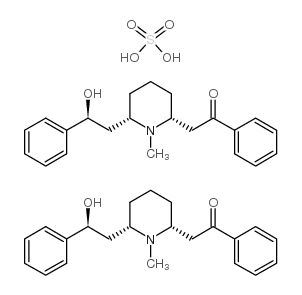134-64-5
| Name | lobeline sulfate |
|---|---|
| Synonyms |
Lobeline sulfate
EINECS 205-151-8 MFCD00135592 2-[(2R,6S)-6-[(2S)-2-hydroxy-2-phenylethyl]-1-methylpiperidin-2-yl]-1-phenylethanone,sulfuric acid |
| Description | Lobeline sulfate (α-Lobeline sulfate; L-Lobeline sulfate) is a nonstimulant medication that can alter dopamine uptake in brain. Lobeline sulfate (α-Lobeline sulfate; L-Lobeline sulfate) inhibits nicotine-induced hyperactivity and is effective in smoking cessation[1][2]. |
|---|---|
| Related Catalog | |
| Target |
IC50: endogenous metabolite[1] |
| References |
| Density | 1.085g/cm3 |
|---|---|
| Boiling Point | 485.6ºC at 760mmHg |
| Melting Point | 152-154 °C |
| Molecular Formula | C44H56N2O8S |
| Molecular Weight | 772.98900 |
| Flash Point | 247.5ºC |
| Exact Mass | 772.37600 |
| PSA | 164.06000 |
| LogP | 8.77580 |
| Vapour Pressure | 3.05E-10mmHg at 25°C |
Synonym: Section 2 - COMPOSITION, INFORMATION ON INGREDIENTS
Risk Phrases: 23/24/25 Section 3 - HAZARDS IDENTIFICATION EMERGENCY OVERVIEW
Toxic by inhalation, in contact with skin and if swallowed.Hygroscopic (absorbs moisture from the air). Potential Health Effects Eye: May cause eye irritation. Skin: May cause skin irritation. Toxic in contact with skin. Ingestion: May cause irritation of the digestive tract. Poison by ingestion. Inhalation: May cause respiratory tract irritation. Toxic if inhaled. Chronic: Repeated exposure may cause central nervous system damage. Section 4 - FIRST AID MEASURES Eyes: Immediately flush eyes with plenty of water for at least 15 minutes, occasionally lifting the upper and lower eyelids. Get medical aid immediately. Skin: Get medical aid immediately. Immediately flush skin with plenty of water for at least 15 minutes while removing contaminated clothing and shoes. Ingestion: Get medical aid immediately. Wash mouth out with water. Inhalation: Get medical aid immediately. Remove from exposure and move to fresh air immediately. If not breathing, give artificial respiration. If breathing is difficult, give oxygen. Notes to Physician: Section 5 - FIRE FIGHTING MEASURES General Information: As in any fire, wear a self-contained breathing apparatus in pressure-demand, MSHA/NIOSH (approved or equivalent), and full protective gear. Extinguishing Media: Use carbon dioxide or dry chemical. Section 6 - ACCIDENTAL RELEASE MEASURES General Information: Use proper personal protective equipment as indicated in Section 8. Spills/Leaks: Vacuum or sweep up material and place into a suitable disposal container. Section 7 - HANDLING and STORAGE Handling: Do not breathe dust, vapor, mist, or gas. Do not get in eyes, on skin, or on clothing. Use only in a chemical fume hood. Storage: Store in a cool, dry place. Store in a tightly closed container. Section 8 - EXPOSURE CONTROLS, PERSONAL PROTECTION Engineering Controls: Use adequate ventilation to keep airborne concentrations low. Exposure Limits CAS# 134-64-5: Personal Protective Equipment Eyes: Not available. Skin: Wear appropriate protective gloves to prevent skin exposure. Clothing: Wear appropriate protective clothing to prevent skin exposure. Respirators: Follow the OSHA respirator regulations found in 29 CFR 1910.134 or European Standard EN 149. Use a NIOSH/MSHA or European Standard EN 149 approved respirator if exposure limits are exceeded or if irritation or other symptoms are experienced. Section 9 - PHYSICAL AND CHEMICAL PROPERTIES Physical State: Powder Color: white Odor: Not available. pH: Not available. Vapor Pressure: Not available. Viscosity: Not available. Boiling Point: Not available. Freezing/Melting Point: 152-154 deg C Autoignition Temperature: Not available. Flash Point: Not available. Explosion Limits, lower: Not available. Explosion Limits, upper: Not available. Decomposition Temperature: Solubility in water: In about 30 parts H2O Specific Gravity/Density: Molecular Formula: C44H56N2O8S Molecular Weight: 773.01 Section 10 - STABILITY AND REACTIVITY Chemical Stability: Stable. Conditions to Avoid: Incompatible materials, exposure to moist air or water. Incompatibilities with Other Materials: Strong oxidizing agents, strong bases, acid chlorides, acid anhydrides. Hazardous Decomposition Products: Hydrogen cyanide, sulfur dioxide, carbon monoxide, oxides of nitrogen, carbon dioxide, sulfuric acid, nitric acid. Hazardous Polymerization: Will not occur. Section 11 - TOXICOLOGICAL INFORMATION RTECS#: CAS# 134-64-5: OJ8490170 LD50/LC50: Not available. Carcinogenicity: Lobeline sulfate - Not listed by ACGIH, IARC, or NTP. Other: See actual entry in RTECS for complete information. Section 12 - ECOLOGICAL INFORMATION Other No information available. Section 13 - DISPOSAL CONSIDERATIONS Dispose of in a manner consistent with federal, state, and local regulations. Section 14 - TRANSPORT INFORMATION IATA Shipping Name: Alkaloid solid, N.O.S.* Hazard Class: 6.1 UN Number: 1544 Packing Group: III IMO Shipping Name: Alkaloid solid, N.O.S. Hazard Class: 6.1 UN Number: 1544 Packing Group: III RID/ADR No information available. Section 15 - REGULATORY INFORMATION European/International Regulations European Labeling in Accordance with EC Directives Hazard Symbols: T Risk Phrases: R 23/24/25 Toxic by inhalation, in contact with skin and if swallowed. Safety Phrases: S 28A After contact with skin, wash immediately with plenty of water. S 36/37/39 Wear suitable protective clothing, gloves and eye/face protection. S 38 In case of insufficient ventilation, wear suitable respiratory equipment. S 45 In case of accident or if you feel unwell, seek medical advice immediately (show the label where possible). WGK (Water Danger/Protection) CAS# 134-64-5: No information available. Canada CAS# 134-64-5 is listed on Canada's DSL List. CAS# 134-64-5 is not listed on Canada's Ingredient Disclosure List. US FEDERAL TSCA CAS# 134-64-5 is not listed on the TSCA inventory. It is for research and development use only. SECTION 16 - ADDITIONAL INFORMATION N/A |
CHEMICAL IDENTIFICATION
HEALTH HAZARD DATAACUTE TOXICITY DATA
|
| Hazard Codes | T:Toxic; |
|---|---|
| Risk Phrases | R23/24/25 |
| Safety Phrases | S45-S38-S36/37/39-S28A |
| RIDADR | 2811 |
| RTECS | OJ8490170 |
| Packaging Group | III |
| Hazard Class | 6.1 |
| HS Code | 2933399090 |
| HS Code | 2933399090 |
|---|---|
| Summary | 2933399090. other compounds containing an unfused pyridine ring (whether or not hydrogenated) in the structure. VAT:17.0%. Tax rebate rate:13.0%. . MFN tariff:6.5%. General tariff:20.0% |
